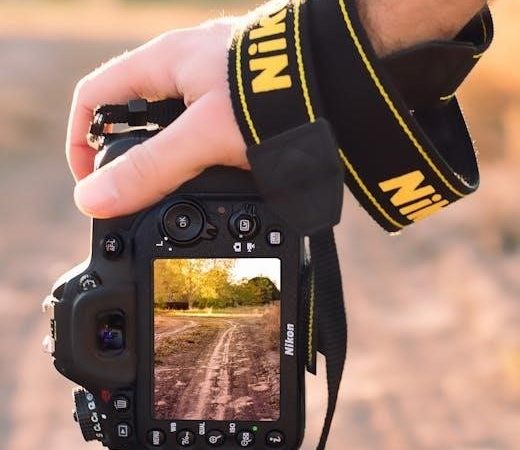The Nikon D3300 DSLR manual provides comprehensive guidance for mastering the camera’s features, including its 24.2MP sensor, EXPEED 4 processor, and ISO range, ensuring optimal photography experiences.
Overview of the Nikon D3300 DSLR Camera
The Nikon D3300 is a high-performance DSLR camera designed for photography enthusiasts and beginners alike. It features a 24.2-megapixel DX-format CMOS sensor without an optical low-pass filter, delivering sharp and detailed images. Paired with the EXPEED 4 image processor, it ensures superior image quality, reduced noise, and fast operation. The camera boasts an ISO range of 100-12,800, expandable to 25,600, making it versatile for various lighting conditions. It supports 1080p video recording at 60fps and includes an 11-point autofocus system for precise subject tracking. Lightweight and ergonomic, the D3300 is ideal for everyday use and travel. Its compatibility with Nikon’s extensive range of AF-S lenses further enhances its versatility, making it a powerful tool for capturing stunning photos and videos. The D3300 is a great choice for those seeking to master DSLR photography.
Importance of the Nikon D3300 Manual
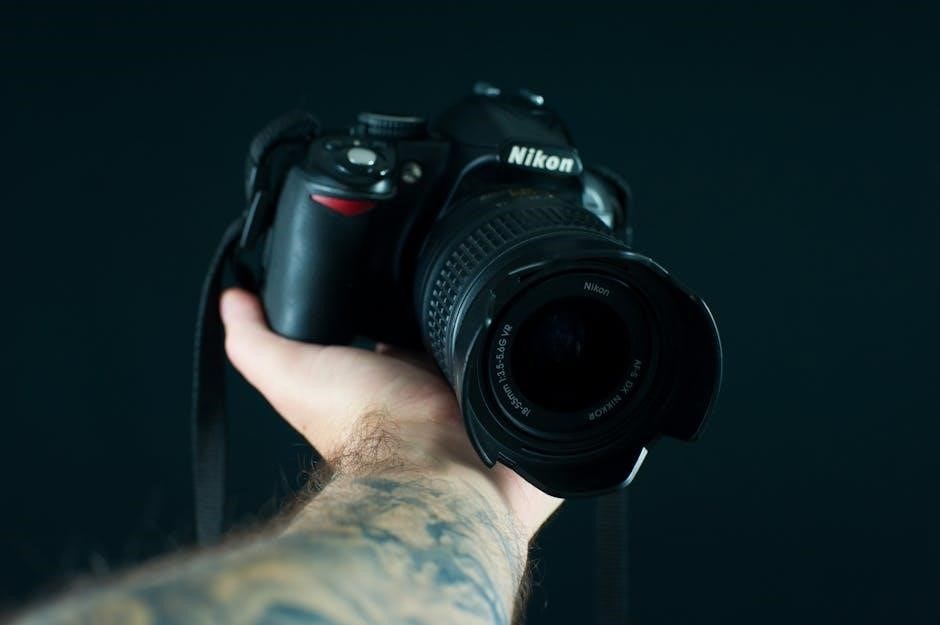
The Nikon D3300 manual is essential for unlocking the camera’s full potential, providing detailed instructions for mastering its features. It guides users through setting up the camera, understanding advanced modes, and troubleshooting common issues. The manual explains how to optimize image quality, use autofocus effectively, and customize settings for personal preferences. Additionally, it covers video recording, live view, and retouch options, enabling users to explore creative possibilities. The manual also highlights the camera’s compatibility with Nikon lenses and accessories, ensuring users can make informed decisions. Whether you’re a novice or an experienced photographer, the manual serves as a comprehensive resource for enhancing your skills and achieving professional-grade results with the D3300.
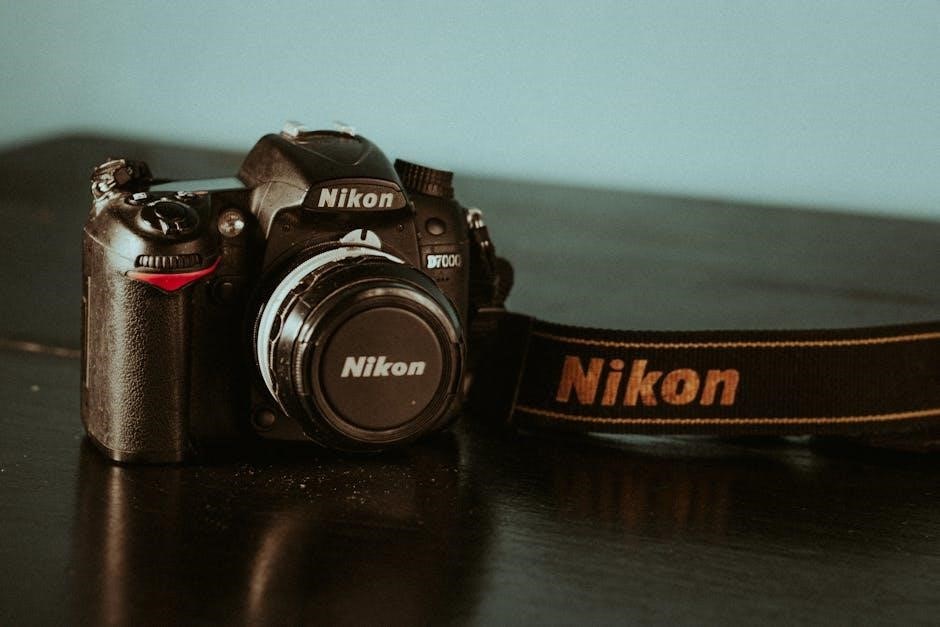
Camera Specifications and Features

The Nikon D3300 manual is crucial for understanding and utilizing the camera’s features effectively. It provides detailed instructions on camera setup, shooting modes, and advanced functions, helping users optimize image quality and autofocus performance. The manual also covers video recording, live view, and retouch options, enabling creative experimentation. Additionally, it explains compatibility with Nikon lenses and accessories, aiding in informed purchasing decisions. Whether for a novice or an experienced photographer, the manual serves as an essential guide for mastering the D3300’s capabilities and achieving professional-grade results. Its comprehensive coverage ensures users can explore all camera functionalities confidently, making it an indispensable resource for photography enthusiasts.
Design and Ergonomics of the Nikon D3300
The Nikon D3300 features a lightweight and compact design, weighing approximately 410g, making it easy to carry for extended periods. Its ergonomic grip is designed for comfort, providing a secure hold during shooting. The camera’s body is constructed from durable materials, ensuring longevity and reliability. The intuitive layout of buttons and dials allows for easy access to key functions, enhancing user experience. The 3-inch LCD screen offers crisp previews and playback, while the optical viewfinder provides precise composition. The design caters to both beginners and advanced photographers, balancing functionality with portability. Its compact size and user-friendly interface make it an ideal choice for capturing high-quality images on the go.
Image Sensor and Processor Details
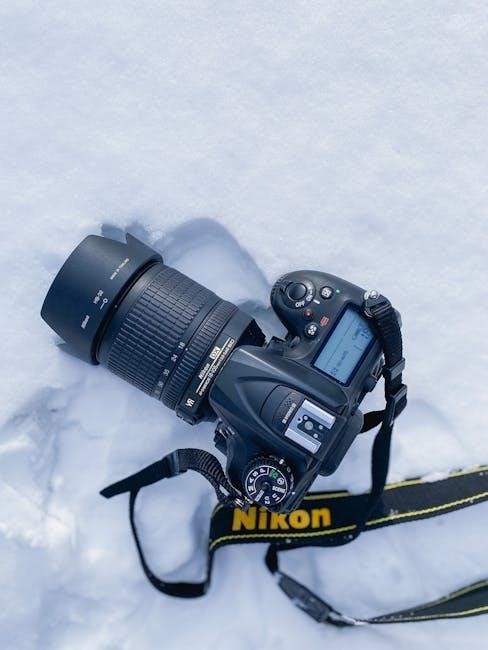
The Nikon D3300 is equipped with a 24.2-megapixel DX-format CMOS sensor, designed without an optical low-pass filter (OLPF), which enhances image sharpness and detail. This sensor works in tandem with the powerful EXPEED 4 image-processing engine, delivering crisp and vibrant images with minimal noise. The combination ensures excellent performance across a wide ISO range, producing high-quality results even in challenging lighting conditions. The sensor’s high resolution allows for detailed captures, while the EXPEED 4 processor optimizes color accuracy and contrast. Together, they enable fast image processing, making the D3300 suitable for both still photography and video recording, ensuring photographers can capture moments with precision and clarity. This advanced technology is a cornerstone of the camera’s impressive imaging capabilities.
ISO Range and Performance
The Nikon D3300 offers an impressive ISO range of 100 to 12,800, extendable to 25,600, enabling versatile shooting in various lighting conditions. The EXPEED 4 processor minimizes noise, ensuring crisp images even at higher ISO settings. In low-light environments, the camera delivers remarkable performance, with minimal grain and preserved detail. While ISO 12,800 shows noticeable noise, it remains manageable for small prints or digital use. The Auto ISO feature allows the camera to adjust sensitivity dynamically, maintaining optimal exposure. This flexibility makes the D3300 suitable for capturing sharp, high-quality images in both bright and challenging lighting scenarios, catering to photographers of all skill levels and preferences. The ISO range and noise reduction capabilities are key strengths of this camera.
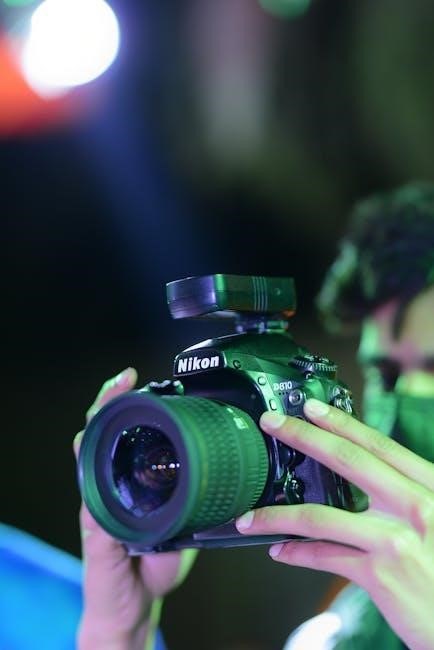
Understanding Camera Modes
The Nikon D3300 offers various camera modes, including Auto, Scene Modes, Program AE, Shutter Priority, Aperture Priority, Manual, and Video Mode, catering to diverse shooting scenarios and skill levels.
Auto Mode and Scene Modes
The Nikon D3300 features an intuitive Auto Mode that simplifies photography by automatically adjusting settings for optimal results. Scene Modes, such as Portrait, Landscape, and Night Portrait, enable users to capture stunning images in specific situations. These modes eliminate the need for manual adjustments, making the camera accessible to beginners. Auto Mode is ideal for everyday shooting, while Scene Modes enhance creativity by tailoring settings to match the scene. Together, they provide a seamless transition from point-and-shoot simplicity to more advanced photography techniques, ensuring high-quality images with minimal effort.
Program AE (P), Shutter Priority (S), Aperture Priority (A), and Manual (M) Modes
The Nikon D3300 offers advanced shooting modes for creative control. Program AE (P) mode automatically adjusts aperture and shutter speed but allows customization. Shutter Priority (S) mode lets users set shutter speed to freeze or blur motion, while Aperture Priority (A) mode enables control over aperture for depth of field. Manual (M) mode provides full control over both aperture and shutter speed for precise results. These modes cater to photographers seeking flexibility and creativity, bridging the gap between automatic and manual photography. They empower users to experiment with lighting, motion, and composition, unlocking the camera’s full potential for professional-grade images.
Video Mode and Live View
The Nikon D3300 supports 1080p HD video recording, offering cinematic quality and smooth motion. Video Mode allows users to capture stunning footage with manual controls for aperture, shutter speed, and ISO. Live View enables real-time preview on the LCD screen, making it easier to frame shots and focus accurately. The camera’s contrast-detection autofocus in Live View ensures sharp video and still images. Accessing Video Mode is straightforward via the mode dial, and settings like frame rates (60p, 50p, 30p, 25p, 24p) can be adjusted in the menu. This feature is ideal for creatives seeking to explore both photography and videography with a single device.
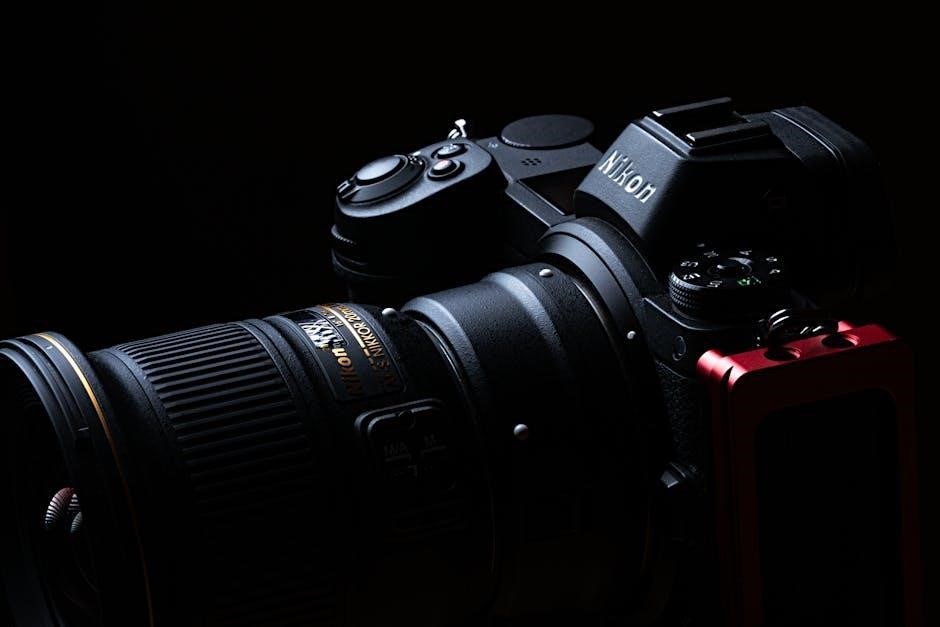
Navigating the Menu System
The Nikon D3300 menu system is organized into Shooting, Playback, Setup, and Retouch menus. Use the multi-selector to navigate and the OK button to select options.
Shooting Menu Options
The Shooting Menu on the Nikon D3300 allows you to customize settings for capturing images. Key options include Image Quality, which lets you choose between RAW, JPEG, or RAW+JPEG formats, and White Balance, which adjusts color temperature for accurate tones. The ISO Sensitivity Settings enable you to set the sensitivity range or assign it to a button for quick access. Picture Controls let you select profiles like Standard, Neutral, or Vivid to tailor image styles. Metering Modes, such as Matrix, Center-Weighted, or Spot, help control exposure. Autofocus Modes (AF-A, AF-C, AF-S) and AF Area Modes (Single-Point, Dynamic, 3D Tracking) are also configurable. Additionally, options like Active D-Lighting and HDR enhance dynamic range and contrast. Bracketing settings for exposure, HDR, and Active D-Lighting enable capturing multiple shots at different settings, which is useful for high-contrast scenes. These options provide flexibility to tailor the camera’s behavior to your shooting style and conditions, ensuring optimal results in various photography scenarios.
Playback Menu Options
The Playback Menu on the Nikon D3300 offers tools for reviewing and managing your images. Key options include Playback Folder, which lets you select folders for image playback, and Hide Image, allowing you to conceal unwanted photos. Playback Display Options enable you to customize the information shown during playback, such as histograms or shooting data. The Image Review feature toggles automatic image preview after capture. Rotate Tall Images adjusts vertical photos for easier viewing. Slide Show creates a timed presentation of your images. Highlight Key Frames marks important moments in video recordings. Additional options like Print Set (DPOF) and Selective Color enhance post-capture adjustments, while Nikon Manual Viewer 2 integration allows smartphone-based menu navigation. These features streamline image review and organization, making post-shooting tasks efficient and intuitive.
Setup Menu Options
The Setup Menu on the Nikon D3300 provides essential tools for customizing camera settings. Key options include Format Memory Card for initializing storage, Monitor Brightness for adjusting the LCD, and Auto Shutdown to conserve battery life. Time Zone and Date lets you set the camera’s clock, while Language allows selection from multiple languages. Firmware Version displays the current software version, and Button Assignment enables customization of camera controls. Additional features like Eye-Fi Upload and Slot Empty Release Lock enhance workflow and security. These options ensure personalized camera operation, optimizing efficiency and user experience. The Setup Menu is crucial for tailoring the D3300 to individual preferences and maintaining peak performance.
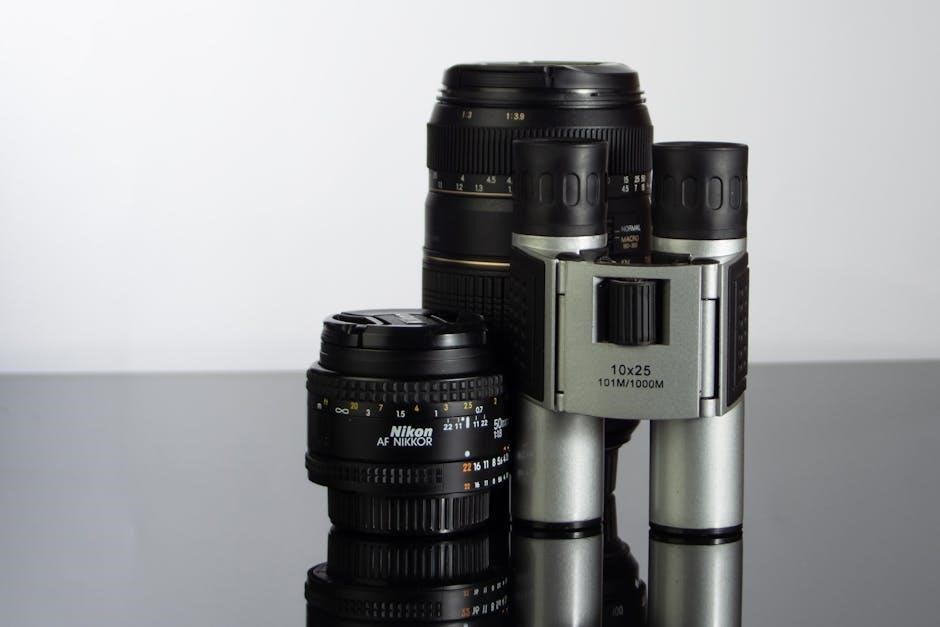
Retouch Menu Options
The Retouch Menu on the Nikon D3300 offers a variety of in-camera editing tools to enhance and modify images without a computer. Options include D-Lighting to adjust shadows and highlights, Red-eye Correction for fixing portraits, and Trim to crop images. Additional features like Monochrome, Filter Effects, and Color Balance allow for creative adjustments. The NEF (RAW) Processing option enables editing of RAW files directly on the camera. These tools provide flexibility for refining photos instantly, making the Retouch Menu a valuable resource for photographers seeking to improve their images on the go. This feature-rich menu simplifies post-processing and enhances creativity, ensuring high-quality results directly from the camera.
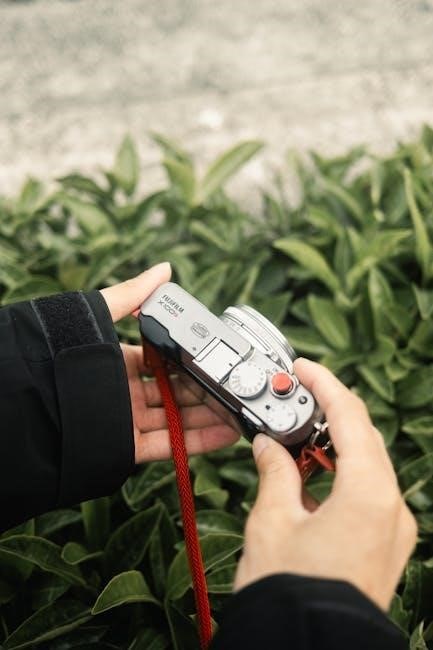
Accessories and Additional Features
The Nikon D3300 supports a range of accessories, including AF-S lenses and the Nikon Manual Viewer 2 app, enhancing functionality and providing convenient access to camera manuals.
Compatible Lenses and Accessories
The Nikon D3300 is compatible with a wide variety of AF-S lenses, including the kit lens AF-S DX NIKKOR 18-55mm f/3.5-5.6G VR II, offering versatility for different photography needs. Additionally, motorized lenses from Sigma and Tamron are supported, ensuring autofocusing capability. The camera also supports external accessories like flashes and remote controls, enhancing functionality. The Nikon Manual Viewer 2 app allows users to access the camera’s manual on their smartphone or tablet, providing easy reference anytime, anywhere. This compatibility ensures users can maximize the camera’s potential with a range of high-quality lenses and accessories tailored for the D3300.
Using the Nikon Manual Viewer 2 App
The Nikon Manual Viewer 2 app allows users to access the D3300’s manual on their smartphone or tablet, providing convenience and easy reference. Available for both iOS and Android devices, the app enables users to view detailed instructions, settings, and troubleshooting guides anytime, anywhere. With features like search, zoom, and bookmarks, it simplifies navigating the camera’s capabilities. The app is particularly useful for quick access to information during shoots or when the physical manual is unavailable. By downloading the Nikon Manual Viewer 2, photographers can ensure they always have guidance at their fingertips to make the most of their D3300.
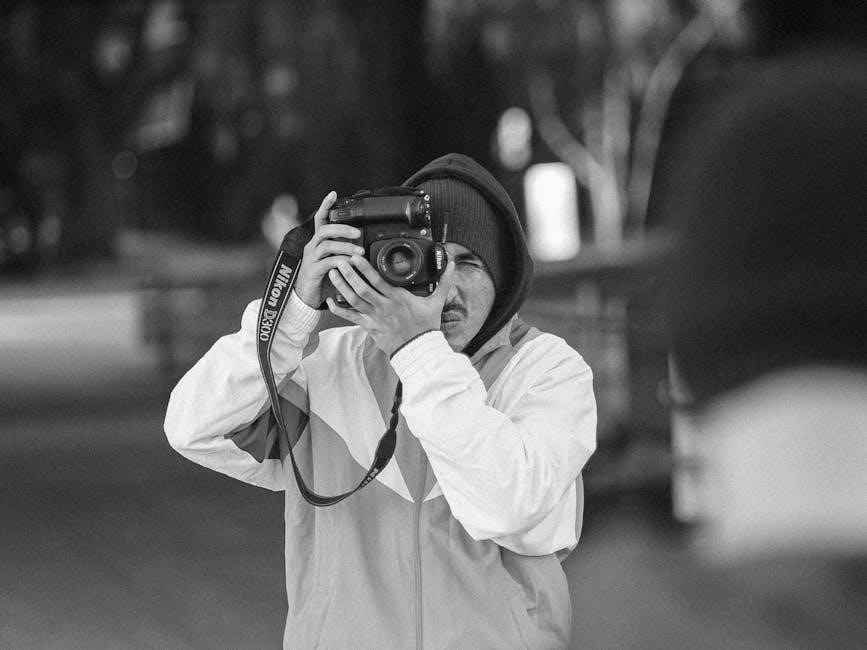
Troubleshooting Common Issues
Address common problems like camera errors, image quality issues, and battery or memory card malfunctions with step-by-step solutions to ensure optimal performance of your Nikon D3300.
Resolving Camera Error Messages
Camera error messages on the Nikon D3300, such as “Forced Exposure” or “Memory Card Full,” indicate specific issues that need immediate attention. These errors often arise from conflicting settings, memory card problems, or sensor malfunctions. To resolve them, refer to the manual or Nikon’s official support resources. For example, if the “Memory Card Full” error appears, check the card’s capacity or format it if necessary. Additionally, using the Nikon Manual Viewer 2 app can provide detailed troubleshooting guides. Regularly cleaning the image sensor and updating firmware can prevent many common errors. Always ensure your camera and accessories are compatible to avoid unexpected issues during shoots.
Image Quality and Focus Problems
Image quality and focus issues with the Nikon D3300 can often be resolved by adjusting settings or cleaning the camera. Blurry images may result from incorrect autofocus modes or low light conditions. Ensure the lens is clean and free of smudges, as dirt can affect image clarity. If focus issues persist, reset autofocus settings to default or use manual focus for precision. The camera’s built-in cleaning mode can remove dust from the sensor, improving image quality. Additionally, updating the camera’s firmware ensures optimal performance. For detailed troubleshooting, refer to the Nikon D3300 manual or use the Nikon Manual Viewer 2 app for guided solutions to enhance your photography experience.
Battery and Memory Card Issues
Battery and memory card issues with the Nikon D3300 can be resolved by following proper maintenance and usage guidelines. Ensure the battery is fully charged using the provided charger, and avoid using third-party accessories that may cause compatibility problems. If the battery drains quickly, reset the camera to factory settings or update the firmware. For memory card issues, format the card in the camera to prevent data loss. Avoid using damaged or incompatible cards, as they may cause errors. Refer to the Nikon D3300 manual for detailed troubleshooting steps. Using the Nikon Manual Viewer 2 app can also provide guided solutions to address these common problems effectively.
The Nikon D3300 DSLR manual is an essential resource for unlocking the camera’s full potential, offering detailed guidance on its features, troubleshooting, and optimal usage techniques.
Final Tips for Mastering the Nikon D3300
- Familiarize yourself with the camera’s 24.2MP sensor and EXPEED 4 processor for stunning image quality.
- Understand ISO settings to balance noise and low-light performance.
- Experiment with modes like Aperture Priority and Shutter Priority for creative control.
- Use the Nikon Manual Viewer 2 app for on-the-go guidance.
- Regularly update firmware for optimal performance.
- Explore compatible lenses to enhance versatility.
- Practice shooting in RAW for better post-processing options.
- Organize photos efficiently using the camera’s playback menu.
- Master focusing techniques for sharp, precise images.
